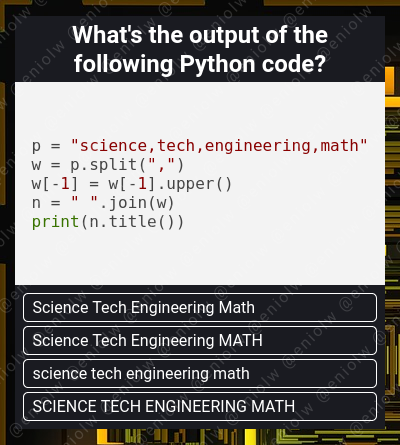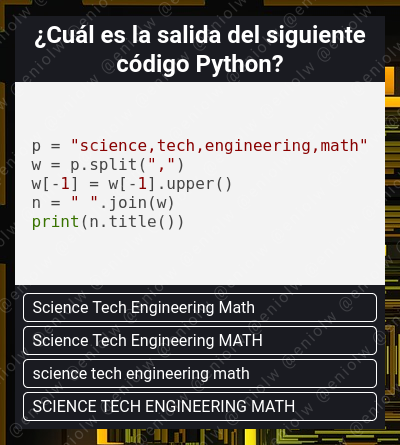My Coding Quiz #20 👨💻🛠️🧩
Welcome to the new installment of my series of Coding Quizzes, in which you will be able to test your knowledge and skills about programming and software development in a simple and fun way. If you want to learn more about it visit my blog here on Hive and the first post where I introduced it.
Without further ado, here's the riddle...

By @eniolw
What's your choice?
Solution to the previous quiz: ('coding ', 'is', ' fun'). Line 1 defines a seemingly meaningless string a. Line 2 reverses this using the familiar slice notation, creating a new string b. Its content will be 'coding is fun'.
Line 3 applies the partition method which is less known, although somewhat similar to split. What it does is look for the string given as an argument and return a three-element tuple. If there is an occurrence, the tuple will be formed by: 1) what is before the first occurrence, 2) the first occurrence and 3) what is after the first occurrence.
In the case of the string b, since the string "is" was specified to the partition method applied to the string 'coding is fun ', this will return the tuple ('coding ', 'is', ' fun'). Note that white spaces are preserved, as they are valid characters.
The enthusiast @splash-of-angs63 solved this test satisfactorily.
If you want to blog about computer science and programming content, I invite you to join Hive and participate in its communities, such as STEM-social, Develop Spanish, Programming & Dev and others.
Mi Quiz de Programación #20 👨💻🛠️🧩
Bienvenido a mi nueva serie de Quizzes de Programación, en la cual podrás poner a prueba tus conocimientos y habilidades sobre programación y desarrollo de software de una manera sencilla y divertida. Si quieres aprender más sobre ella visita mi blog aquí en Hive y el primer post donde la presenté.
Sin más preámbulos, he aquí el acertijo...

Por @eniolw
¿Cuál es tu elección?
Solución al quiz anterior: ('coding ', 'is', ' fun'). La línea 1 define un string a aparentemente sin sentido. La línea 2 lo invierte usando la conocida notación de rebanada, creando un nuevo string b. Su contenido será 'coding is fun'.
La línea 3 le aplica el método partition que es menos conocido, aunque algo similar a split. Lo que hace es buscar la cadena dada como argumento y devolver una tupla de tres elementos. En caso de haber una ocurrencia, la tupla estará formada por: 1) lo que esté antes de la primera ocurrencia, 2) la primera ocurrencia y 3) lo que esté tras la primera ocurrencia.
En el caso del string b, dado que se especificó la cadena "is" al método partition aplicado al string 'coding is fun', este regresará la tupla ('coding ', 'is', ' fun'). Nótese que los espacios en blanco se preservan, pues son caracteres válidos.
El entusiasta @splash-of-angs63 resolvió este test satisfactoriamente.
Si quieres bloguear sobre contenido informático y de programación, te invito a unirte a Hive y participar en sus comunidades, tales como STEM-social, Develop Spanish, Programming & Dev y otras.
